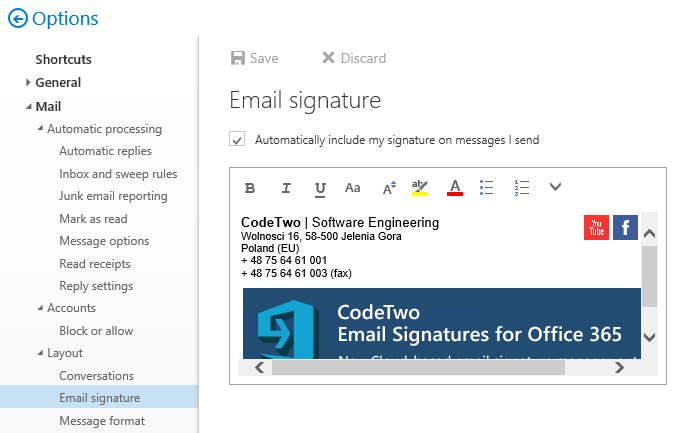

I opened each of the folders and looked at the contents. That unfortunately didn't work for me, so I decided to try something else that did work. As AussiePiper rightly suggests in his post above, right-clicking on the "Main Identity.rge" will allow you to "Show package contents" and then you will see this list of folders:Īnd this is where I went another step beyond AussiePiper's suggestion to double-click on each folder with the intention of getting them to open into Outlook 2016. (Note that the export process takes a fair while, but eventually "Main Identity.rge" will appear on your desktop).
#Import signatures into outlook 2016 archive#
I used AussiePiper's method of right clicking on the "Main Identity.rge" archive file that results when you choose "Export" in Entourage's file menu, and then select "items to an Entourage archive" in the first little window that appears. I did finally manage it without going through Outlook 2011. I am sure there are others out there if you search for them. I trialled "Mail To PST Converter" from the developer and it worked fine for Outlook 2016, but that is just one example. There are some available through the App store.

pst converter to get your email files into Outlook, which tend only to run on Windows. It was a big mess, but it was manageable, even if somewhat tedious. mbox files doubled up the folders - so there was for example an "Inbox" folder within an "Inbox" folder - but all the mail was still intact. When I imported them into Mail.app manually the. Mail folders are in their original hierarchy with the. (If not try setting Outlook as the default program in the info panel and then clicking the "Change All" button/pull down menu under the "Use this application to open all documents like this one." message) Outlook won't let you "import" the events, contacts or tasks, etc., but if you double click on any of them they will open up in Outlook by default. rge archive and select "Show Package Contents", you'll find it is actually just a set of folders named Calendar, Contacts, Mail, Notes and Tasks. If you Ctrl+click (or right click) on your. For example, contacts are in the navigation pane on the People tab, email messages are in the navigation pane on the Mail tab, calendar items are in the navigation pane on the Calendar tab, and so on.Don't know if you found your solution yet but I am sure others are still looking. Imported items appear on the navigation panes (Mail, Calendar, People, Tasks, Notes) under On My Computer. olm file on your Mac, and then choose Import.
#Import signatures into outlook 2016 for mac#
In the Import box, select Outlook for Mac archive file (.olm) > Continue. In Outlook 2016 for Mac or Outlook 2019 for Mac, on the Tools tab, choose Import. olm file to the new one (see the Apple web site for instructions). If moving from one Mac to another, transfer the. olm file and note the location where you save that file. olm file because you'll need it during the import process.Įxport your Outlook for Mac email messages, contacts, calendar items, tasks, and notes to a.

If you're moving from one Mac to another or upgrading from Outlook for Mac 2011 to Outlook 2016 for Mac or Outlook 2019 for Mac, export your email messages, contacts, calendar items, tasks, and notes to a. olm file is the data file used by Outlook for Mac to archive your email messages, contacts, calendar items, tasks, and notes.


 0 kommentar(er)
0 kommentar(er)
